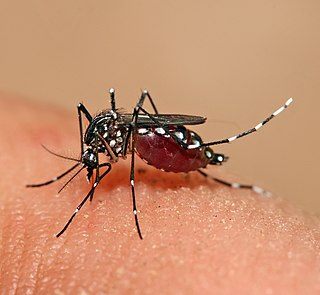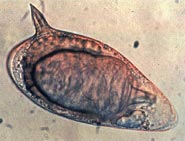Description
| | This section is empty. You can help by adding to it. (June 2011) |
| Trophosphaera | |
|---|---|
| Scientific classification | |
| Domain: | |
| (unranked): | |
| (unranked): | |
| Phylum: | |
| Class: | |
| Subclass: | |
| Order: | |
| Genus: | Trophosphaera |
| Species | |
Trophosphaera is a genus of parasites of the phylum Apicomplexa.
Only one species (Trophosphaera planorbulinae) is known for this genus.
This genus was described in 1939 by Le Calvez. [1]
| | This section is empty. You can help by adding to it. (June 2011) |

Leishmania is a parasitic protozoan, a single-celled organism of the genus Leishmania that are responsible for the disease leishmaniasis. They are spread by sandflies of the genus Phlebotomus in the Old World, and of the genus Lutzomyia in the New World. At least 93 sandfly species are proven or probable vectors worldwide. Their primary hosts are vertebrates; Leishmania commonly infects hyraxes, canids, rodents, and humans.

Aedes or Pointy Mosquito is a genus of mosquitoes originally found in tropical and subtropical zones, but now found on all continents except Antarctica. Some species have been spread by human activity: Aedes albopictus, a particularly invasive species, was spread to the Americas, including the United States, in the 1980s, by the used-tire trade.

Schistosoma is a genus of trematodes, commonly known as blood flukes. They are parasitic flatworms responsible for a highly significant group of infections in humans termed schistosomiasis, which is considered by the World Health Organization as the second-most socioeconomically devastating parasitic disease, with hundreds of millions infected worldwide.

Microsporidia are a group of spore-forming unicellular parasites. These spores contain an extrusion apparatus that has a coiled polar tube ending in an anchoring disc at the apical part of the spore. They were once considered protozoans or protists, but are now known to be fungi, or a sister group to fungi. These fungal microbes are obligate eukaryotic parasites that use a unique mechanism to infect host cells. They have recently been discovered in a 2017 Cornell study to infect Coleoptera on a large scale. So far, about 1500 of the probably more than one million species are named. Microsporidia are restricted to animal hosts, and all major groups of animals host microsporidia. Most infect insects, but they are also responsible for common diseases of crustaceans and fish. The named species of microsporidia usually infect one host species or a group of closely related taxa. Approximately 10 percent of the species are parasites of vertebrates —several species, most of which are opportunistic, can infect humans, in whom they can cause microsporidiosis.

Pierrot the Clownfish is a French children's book by author Franck Le Calvez.

Anne-Sophie Calvez is a French former competitive figure skater. She is the 2007 French national champion and 2003–2005 national silver medalist. She reached the free skate at four ISU Championships – 2003 Europeans in Malmö, Sweden, where she achieved her highest placement, 11th; 2003 Worlds in Washington, D.C., United States; 2004 Worlds in Dortmund, Germany; and 2007 Europeans in Warsaw, Poland.

Blastocladiomycota is one of the currently recognized phyla within the kingdom Fungi. Blastocladiomycota was originally the order Blastocladiales within the phylum Chytridiomycota until molecular and zoospore ultrastructural characters were used to demonstrate it was not monophyletic with Chytridiomycota. The order was first erected by Petersen for a single genus, Blastocladia, which was originally considered a member of the oomycetes. Accordingly, members of Blastocladiomycota are often referred to colloquially as "chytrids." However, some feel "chytrid" should refer only to members of Chytridiomycota. Thus, members of Blastocladiomyota are commonly called "blastoclads" by mycologists. Alternatively, members of Blastocladiomycota, Chytridiomycota, and Neocallimastigomycota lumped together as the zoosporic true fungi. Blastocladiomycota contains 5 families and approximately 12 genera. This early diverging branch of kingdom Fungi is the first to exhibit alternation of generations. As well, two (once) popular model organisms—Allomyces macrogynus and Blastocladiella emersonii—belong to this phylum.

Léon Le Calvez was a French professional road bicycle racer. In the 1931 Tour de France, Le Calvez was wearing the yellow jersey for one day.

Lutjanidae, or snappers are a family of perciform fish, mainly marine, but with some members inhabiting estuaries, feeding in fresh water. The family includes about 113 species. Some are important food fish. One of the best known is the red snapper.
Arhythmacanthidae is a family of parasitic worms from the order Echinorhynchida.

Rhadinorhynchidae is a family of parasitic worms from the order Echinorhynchida.
Haemosporidiasina (Haemosporidia) is a subclass of apicomplexans described by Jacques Euzéby in 1988. The taxon is very similar to Aconoidasida.
Achromatorida is an order of non-pigmented intraerythrocytic parasitic alveolates belonging to the subclass Haemosporidiasina. The order was created by Jacques Euzéby in 1988.

Louis-Joseph Alcide Railliet was a French veterinarian and helminthologist.
Jean-Yves Calvez was a French Jesuit, theologian, philosopher, economist, expert in Marxism and professor of social philosophy.
Pseudoklossia is a genus in the phylum Apicomplexa. Species in this genus infect marine molluscs, although one species infects in an ascidian worm. The life cycle is heteroxenous.
Filipodium is a genus of parasites in the phylum Apicomplexa. Species in this genus infect marine invertebrates.

Cucullanus is a genus of parasitic nematodes. The genus includes more than 100 species.

Céline Calvez is a French politician of Renaissance (RE) who has represented the 5th constituency of the Hauts-de-Seine department in the National Assembly since 2017.

František Moravec is a Czech parasitologist who specialises on the Nematodes, especially the nematodes parasites of fishes. His research is mainly in the field of taxonomy of the Nematoda.